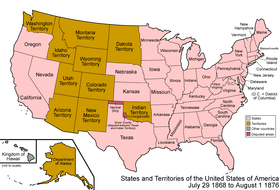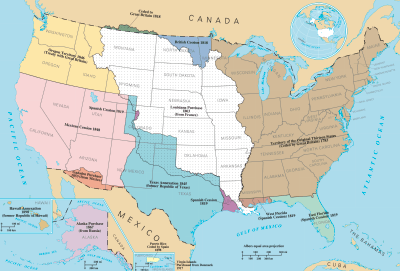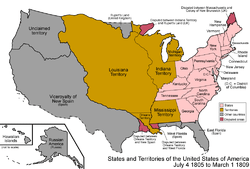Organized incorporated territories of the United States

• The Oregon Country to the upper left was in dispute with and later co-managed by Great Britain.
• The American Southwest was added to the United States after the Mexican–American War (1846–1848).
• The Louisiana Purchase would continue to be divided into separate states. (See Map below in list section.)

Organized incorporated territories are territories of the United States that are both incorporated (part of the United States proper) and organized (having an organized government authorized by an Organic Act passed by the U.S. Congress, usually consisting of a territorial legislature, territorial governor, and a basic judicial system). There have been no such territories since Alaska and Hawaii were admitted as states in 1959.
Through most of U.S. history, regions that were admitted as U.S. states were, prior to admission, territories or parts of territories of this kind. As the United States grew, the most populous parts of the organized territory would achieve statehood. The remainder frequently kept at least some of the governing structure of the old legal entity (territory) and would be renamed to avoid confusion.
Some territories existed only a short time before becoming states, while others remained territories for decades. The shortest-lived was Alabama Territory at two years, while New Mexico Territory and Hawaii Territory both lasted more than 50 years.
Historical
Of the current 50 U.S. states, 31 were at one time or another part of a U.S. territory (see list below). The exceptions include: the original Thirteen Colonies; Kentucky and West Virginia (both split off from Virginia); Maine (split off from Massachusetts); California (created as a state out of the unorganized territory of the Mexican Cession); and Vermont and Texas (both previously self-declared republics).
Common regional names such as Louisiana Purchase, Indian Territory, and Oregon Country were never formally organized as territories.
During the American Civil War, there was (at least nominally) a Confederate-established Arizona Territory (1861–1865), which split Arizona and New Mexico along an east–west line, rather than the Union-established north–south line that persists today. See article for map.
Current situation
Since 1959, there have been no incorporated U.S. territories formally organized by an Organic Act. When Hawaii was admitted as a state in 1959, the Hawaii Admission Act specifically excluded Palmyra Island which had been part of the Territory of Hawaii, and Palmyra remains today as the only incorporated U. S. territory, the United States Territory of Palmyra Island. Although it still has private landowners, Palmyra is uninhabited, and no Palmyra Island government has been organized under an act of Congress. Palmyra is currently governed as a territory by the United States Department of the Interior.[1] All other U. S. territories except Palmyra are unincorporated (meaning that they are not fully part of the United States and that not all aspects of the United States Constitution automatically apply), whereas other former incorporated territories (excepting only Palmyra Island) are now states. While the District of Columbia functions similarly to an organized incorporated territory, it is governed by entirely different provisions of the United States Constitution as a federal district.
List of organized incorporated territories


The following territories within the United States were officially organized by Congress with an Organic Act on the first date listed. Each was admitted as a U.S. state (of the same name, except where noted) on the second date listed. Often, larger outlying portions of an organized territory were not included in the new state.
For maps, see Territorial evolution of the United States.
- Northwest Territory (1787–1803) became the State of Ohio and the Indiana Territory (1800)
- Southwest Territory (1790–1796) became the State of Tennessee
- Mississippi Territory (1798–1817) became the State of Mississippi and Alabama Territory
- Indiana Territory (1800–1816) became western Michigan Territory (1805), Illinois Territory (1809), and the State of Indiana
- Territory of Orleans (1804[2]–1812) became the State of Louisiana[3]
- Michigan Territory (1805–1837) became Wisconsin Territory (1836) and the State of Michigan
- Louisiana Territory (1805–1812), renamed Missouri Territory
- Illinois Territory (1809–1818) became the State of Illinois, and part of the Michigan Territory
- Missouri Territory (1812–1821) became the State of Missouri and the rest unorganized
- Alabama Territory (1817–1819)
- Arkansas Territory (1819–1836) became the State of Arkansas and unorganized Indian Territory
- Florida Territory (1822–1845) became the state of Florida
- Wisconsin Territory (1836–1848) became the Iowa Territory (1838), and the State of Wisconsin, with a portion becoming part of the Minnesota Territory
- Iowa Territory (1838–1846) became the State of Iowa and the rest unorganized
- Oregon Territory (1848–1859)
- Minnesota Territory (1849–1858), the eastern part of which became the state of Minnesota
- New Mexico Territory (1850–1912)
- Utah Territory (1850–1896)
- Washington Territory (1853–1889)
- Kansas Territory (1854–1861)
- Nebraska Territory (1854–1867)
- Colorado Territory (1861–1876)
- Nevada Territory (1861–1864)
- Dakota Territory (1861–1889) became the Idaho Territory (1863), and the States of North Dakota and South Dakota
- Arizona Territory (1863–1912)
- Idaho Territory (1863–1890)
- Montana Territory (1864–1889)
- Wyoming Territory (1868–1890)
- Oklahoma Territory (1890–1907)
- Territory of Hawaii (1900–1959) (the Territory of Palmyra Island is a remnant)
- Territory of Alaska (1912–1959)
See also
- Historic regions of the United States
- Insular areas of the United States
- Insular Cases
- Political divisions of the United States
- Territorial evolution of the United States
- Territories of the United States – foreign possessions, legal classifications
- Territories of the United States on stamps
- United States territorial acquisitions
References
- ↑ "GAO/OGC-98-5 – U.S. Insular Areas: Application of the U.S. Constitution". U.S. Government Printing Office. November 7, 1997. Retrieved March 18, 2018.
- ↑ "An Act erecting Louisiana into two territories and providing for the temporary government thereof"
- ↑ "An Act for the admission of the state of Louisiana into the Union, and to extend the laws of the United States to the said state"